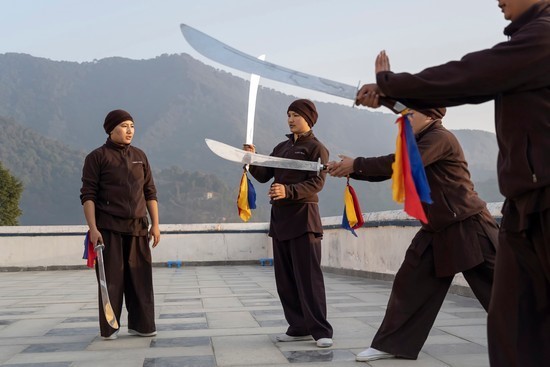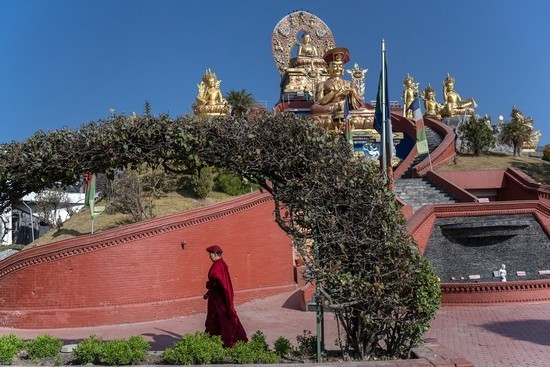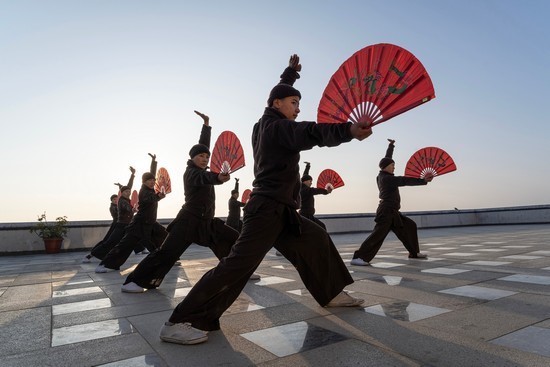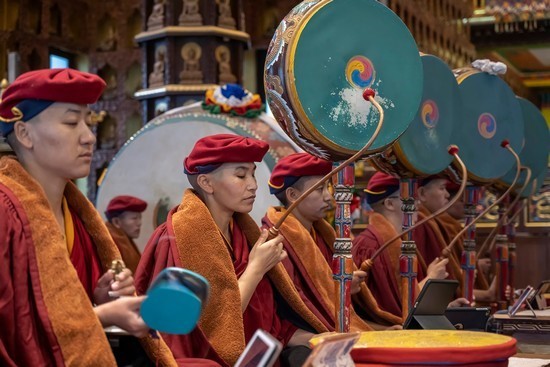NAGARJUN, Nepal — As the first rays
of sun pierced through the clouds covering snowcapped Himalayan peaks, Jigme
Rabsal Lhamo, a Buddhist nun, drew a sword from behind her back and thrust it
toward her opponent, toppling her to the ground.
اضافة اعلان
“Eyes on the target! Concentrate!” Lhamo
yelled at the knocked-down nun, looking straight into her eyes outside a
whitewashed temple in the Druk Amitabha nunnery on a hill overlooking
Kathmandu, the capital of Nepal.
Lhamo and the other members of her
religious order are known as the Kung Fu nuns, part of an 800-year-old Buddhist
sect called Drukpa, the Tibetan word for dragon. Across the Himalayan region,
and the wider world, its followers now mix meditation with martial arts.
 Nuns
practice Kung Fu with swords at Druk Amitabha Nunnery, on a hill overlooking
Kathmandu, Nepal, on February 4, 2023.
Nuns
practice Kung Fu with swords at Druk Amitabha Nunnery, on a hill overlooking
Kathmandu, Nepal, on February 4, 2023.
Every day, the nuns swap their maroon robes
for an umber brown uniform to practice Kung Fu, the ancient Chinese martial
art. It is part of their spiritual mission to achieve gender equality and
physical fitness; their Buddhist beliefs also call on them to lead an
environmentally friendly life.
Mornings inside the nunnery are filled with
the thuds of heavy footsteps and the clanking of swords as the nuns train under
Lhamo’s tutelage. Amid a soft rustle of their loose uniforms, they cartwheel,
punch, and kick one another.
“Kung Fu helps us to break gender barriers
and develop inner confidence,” said Lhamo, 34, who arrived at the nunnery a
dozen years ago from Ladakh, in northern India. “It also helps to take care of
others during crises.”
Battling stigmasFor as long as scholars of Buddhism remember,
women in the Himalayas who sought to practice as spiritual equals with male
monks were stigmatized, both by religious leaders and broader social customs.
Barred from engaging in the intense
philosophic debates encouraged among monks, women were confined to chores like
cooking and cleaning inside monasteries and temples. They were forbidden from
activities involving physical exertion or from leading prayers or even from
singing.
 A
nun walks around a stupa (Buddhist shrine) at Druk Amitabha Nunnery, on a hill
overlooking Kathmandu, Nepal, on February 3, 2023.
A
nun walks around a stupa (Buddhist shrine) at Druk Amitabha Nunnery, on a hill
overlooking Kathmandu, Nepal, on February 3, 2023.
In recent decades, those restrictions have
become the heart of a raging battle waged by thousands of nuns across many
sects of Himalayan Buddhism.
Leading the charge for change are the Kung
Fu nuns, whose Drukpa sect began a reformist movement 30 years ago under the
leadership of Jigme Pema Wangchen, who is also known as the 12th Gyalwang
Drukpa. He was willing to disrupt centuries of tradition and wanted nuns who
would carry the sect’s religious message outside monastery walls.
“We are changing rules of the game,” said Konchok Lhamo, 29, a Kung Fu nun. “It is not enough to meditate on a cushion inside a monastery.”
“We are changing rules of the game,” said
Konchok Lhamo, 29, a Kung Fu nun. “It is not enough to meditate on a cushion
inside a monastery.”
Pilgrimages for the planetToday, Drukpa nuns not only practice Kung
Fu but also lead prayers and walk for months on pilgrimages to pick up plastic
litter and make people aware of climate change.
Every year for the past 20, except for a
hiatus during the pandemic, the nuns have cycled about 2,000km from Kathmandu
to Ladakh, high in the Himalayas, to promote green transportation.
 Nuns practice Kung Fu early in the morning
at Druk Amitabha Nunnery, on a hill overlooking Kathmandu, Nepal, on February
3, 2023.
Nuns practice Kung Fu early in the morning
at Druk Amitabha Nunnery, on a hill overlooking Kathmandu, Nepal, on February
3, 2023.
Along the way, they stop to educate people
in rural parts of both Nepal and India about gender equality and the importance
of girls.
The sect’s nuns were first introduced to
martial arts in 2008 by followers from Vietnam, who had come to the nunnery to
learn scriptures and how to play the instruments used during prayers.
Since then, about 800 nuns have been
trained in martial arts basics, with around 90 going through intense lessons to
become trainers.
The 12th Gyalwang Drukpa has also been
training the nuns to become chant masters, a position once reserved only for
men. He has also given them the highest level of teaching, called Mahamudra, a
Sanskrit word for “great seal”, an advanced system of meditation.
Caring for creatures, societyThe nuns have become well known both in Hindu-majority
Nepal, which is about 9 percent Buddhist, and beyond the country’s borders.
But the changes for the sect have not come
without intense backlash, and conservative Buddhists have threatened to burn
Drukpa temples.
During their trips down the steep slopes
from the nunnery to the local market, the nuns have been verbally abused by
monks from other sects. But that does not deter them, they say. When they
travel, heads shaved, on trips in their open vans, they can look like soldiers
ready to be deployed on the front line and capable of confronting any bias.
The sect’s vast campus is home to 350 nuns,
who live with ducks, turkeys, swans, goats, 20 dogs, a horse, and a cow, all
rescued either from the knife of butchers or from the streets. The women work
as painters, artists, plumbers, gardeners, electricians, and masons, and also
manage a library and medical clinic for laypeople.
“When people come to the monastery and see us working, they start thinking being a nun is not being ‘useless’... We are not only taking care of our religion but the society, too.”
“When people come to the monastery and see
us working, they start thinking being a nun is not being ‘useless’,” said Zekit
Lhamo, 28, referring to an insult sometimes hurled at the nuns. “We are not
only taking care of our religion but the society, too.”
Their work has inspired other women in
Nepal’s capital.
 Nuns
offer prayers for the sick or deceased at Druk Amitabha Nunnery, on a hill
overlooking Kathmandu, Nepal, on February 4, 2023.
Nuns
offer prayers for the sick or deceased at Druk Amitabha Nunnery, on a hill
overlooking Kathmandu, Nepal, on February 4, 2023.
“When I look at them, I want to become a
nun,” said Ajali Shahi, a graduate student at Tribhuvan University in
Kathmandu. “They look so cool, and you want to leave everything behind.”
Every day, the nunnery receives at least a
dozen inquiries about joining the order from places as far as Mexico, Ireland,
Germany, and the US.
“But everyone can’t do this,” said Jigme
Yangchen Ghamo, a nun. “It looks attractive from outside, but inside it is a
hard life.”
Read more Odd and Bizarre
Jordan News



